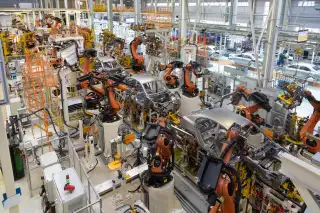'Shockingly Weak': These Economic Indicators Are Flashing Red, According to Experts

With the stock market up and jobs plentiful, the U.S. economy appears to be hitting on all cylinders. Not so fast, say many investors.
Earlier this month the S&P 500 hit a record high. Meanwhile the U.S. unemployment rate, at 3.6%, is the lowest it's been since at least the late 1990s. President Trump, for one, has been quick to herald these successes.
But there may be trouble just beneath the surface, say experts. Indeed, even the recent stock market high came in response to downbeat news on the economy: the rally followed followed an announcement that the Federal Reserve could soon decide to cut short-term interest rates. While that makes it cheaper for corporations to borrow (hence the stock market rally), it's a sign policymakers are fretting about the economy's long-term health.
So, what exactly is to worry about? Here are five signs experts say the economy is about weaken.
A topsy-turvy bond market
Earlier this year the bond market started flashing one of its most reliable recession signals: Yields on long-dated Treasurys slipped below those of shorter dated ones, suggesting fixed-income investors foresee slow rates of growth and modest inflation in coming years. (Investors rush to buy longer-dated bonds, locking in today's comparatively high yields. But as those bonds' prices rise, their yields fall). The event, known as a yield curve inversion, made headlines when it first happened in March, but lasted only a week. That, along with some recent tinkering in the bond market by the Federal Reserve, led many to ignore the indicator, which has historically suggested a recession could take place in the next year or two.
Starting in May, however the yield curve inverted again. This time around the inversion has lasted a month and counting, making it much harder to write off. "Almost 60% of the US yield curve now inverted, said Crescat Capital analyst Otavio Costa, in a recent tweet, referring to different bond maturities along the curve. "We are at the pinnacle of a historic bubble. At any moment, the wheels will come off."
Struggling manufacturers
President Trump has put U.S. manufacturing jobs at the center of his economic vision. Earlier this month, however, the closely watched ISM manufacturing index fell to 52.1 for May from 52.8 for April. While any number over 50 suggests manufacturing businesses are still expanding, commentators were quick to point out the May reading was the lowest level of the Trump presidency. Since then regional manufacturing indicators have also shown weakness. On June 18, the New York Fed said the Empire State Manufacturing Index posted its largest one-month drop on record, a "shockingly weak" result, according to a note by Maria Fiorini Ramirez Inc. Chief Economist Joshua Shapiro.
One big culprit: Trump's trade war with China. The Trump Administration hopes tariffs on Chinese goods will aid U.S. manufacturers in the long run by making imports comparatively more expensive for U.S. consumers. In the short run, however, it's hurting, according to business executives quoted in the ISM survey who blamed the tariffs for higher materials costs and snarled supply chains.
A looming earnings recession
The 2017 Tax Cuts and Jobs Act gave U.S. companies a big boost last year by slashing the corporate tax rate, thereby increasing profits. The bad news: Companies can't count on lower rates for another year-over-year bump. That has a many market watchers worried about what they call an earnings recession -- typically defined as two or more quarters in which corporate profits contract. After noticeably weak profits in last quarter of 2018 -- which prompted the Dow's worst December since the 1930s -- earnings recovered somewhat during the first quarter.
Now, however, a relatively weak global economy, rising U.S. wages and trade tensions with China are putting the pressure back on. Wall Street analysts expect corporate earnings to decline 2.6% for the second quarter and 0.3% for the third before rebounding later this year, according to CNBC. Some investors may still be too optimistic. "We saw companies that did poorly in the first quarter hold on to strong fourth-quarter guidance and maintain optimism," said Morgan Stanley Equity Strategist Michael Wilson in a recent note. "We don't buy this story," he added.
Softening home prices
While it may not seem like it if you're a millennial trying to buy a first home, the U.S. real estate market has slowed considerably over the past several months. On Tuesday the widely watched S&P CoreLogic Case-Shiller index showed U.S. home prices grew 3.5% year over year in April. While still positive, that represents the slowest growth rate in seven years.
By at least one lesser-watched measure, housing website Zillow's compilation of national home values, prices actually declined between April and March. If the market does continue to weaken, that would be bad news. A housing downturn has preceded every U.S. recession since the 1950s, according the Fed.
Wary consumers
Bullish U.S. consumers, encouraged by a humming job market, have been one of economy's strongest pillars. Even here, however, cracks are starting to show. Earlier this week the Conference Board said its index of consumer sentiment fell to 121.5, its lowest level in nearly two years. The reading was below all forecasts by analysts that Bloomberg polled. While unemployment remains low, there are also signs of softening in the job market, with the U.S. adding just 75,000 jobs in May, compared to an average of 212,000 over the previous 12 months.
While consumers' confidence remains historically high, the recent dip "highlights the risk of ‘talking ourselves into a recession’,” according to Greg McBride, the chief financial analyst for Bankrate.com. “Consumers that think the economy is weak will spend less and business owners that think the economy is weak won’t hire more people.”